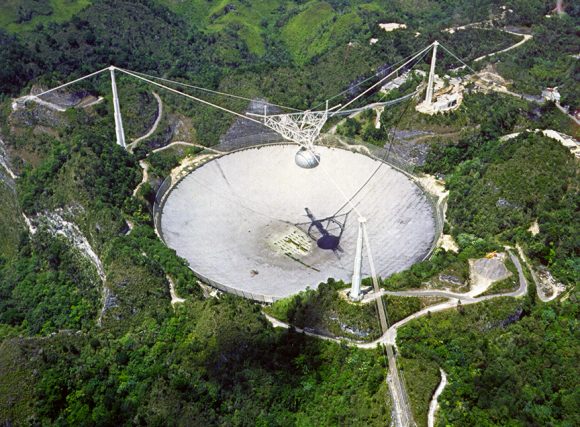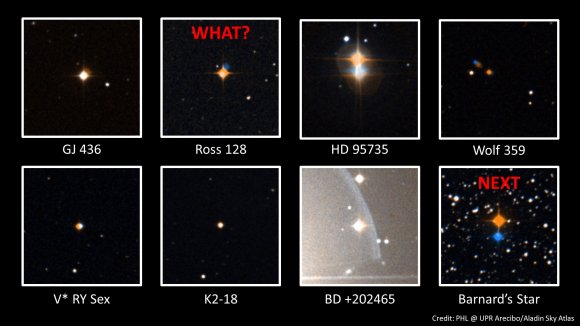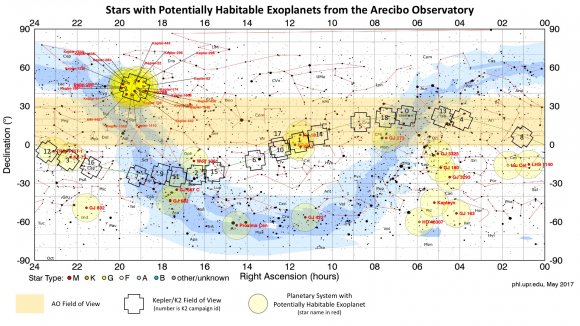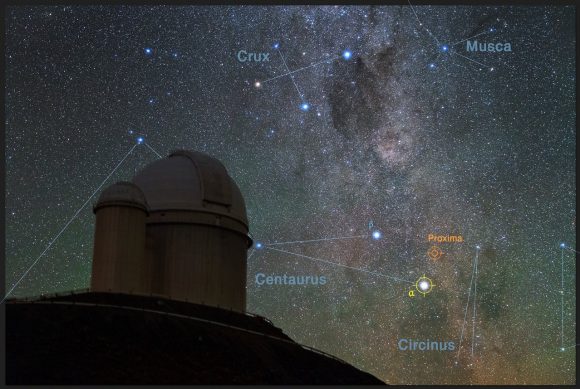Astronomers have been listening to radio waves from space for decades. In addition to being a proven means of studying stars, galaxies, quasars and other celestial objects, radio astronomy is one of the main ways in which scientists have searched for signs of extra-terrestrial intelligence (ETI). And while nothing definitive has been found to date, there have been a number of incidents that have raised hopes of finding an “alien signal”.
In the most recent case, scientists from the Arecido Observatory recently announced the detection of a strange radio signal coming from Ross 128 – a red dwarf star system located just 11 light-years from Earth. As always, this has fueled speculation that the signal could be evidence of an extra-terrestrial civilization, while the scientific community has urged the public not to get their hopes up.
The discovery was part of a campaign being conducted by Abel Méndez – the director of the Planetary Habitability Laboratory (PHL) in Peurto Rico – and Jorge Zuluaga of the Faculty of Exact and Natural Sciences at the University of Antioquia, Colombia. Inspired by the recent discoveries around Proxima Centauri and TRAPPIST-1, the GJ 436 campaign relied on data from Arecibo Observatory to look for signs of exoplanets around nearby red dwarf stars.

In the course of looking at data from stars systems like Gliese 436, Ross 128, Wolf 359, HD 95735, BD +202465, V* RY Sex, and K2-18 – which was gathered between April and May of 2017 – they noticed something rather interesting. Basically, the data indicated that an unexplained radio signal was coming from Ross 128. As Dr. Abel Mendez described in a blog post on the PHL website:
“Two weeks after these observations, we realized that there were some very peculiar signals in the 10-minute dynamic spectrum that we obtained from Ross 128 (GJ 447), observed May 12 at 8:53 PM AST (2017/05/13 00:53:55 UTC). The signals consisted of broadband quasi-periodic non-polarized pulses with very strong dispersion-like features. We believe that the signals are not local radio frequency interferences (RFI) since they are unique to Ross 128 and observations of other stars immediately before and after did not show anything similar.”
After first noticing this signal on Saturday, May 13th at 8:53 p.m., scientists from the Arecibo Observatory and astronomers from the Search for Extra-Terrestrial Intelligence (SETI) Institute teamed up to conduct a follow-up study of the star. This was performed on Sunday, July 16th, using SETI’s Allen Telescope Array and the National Radio Astronomy Observatory‘s (NRAO) Green Bank Telescope.
They also conducted observations of Barnard’s star on that same day to see if they could note similar behavior coming from this star system. This was done in collaboration with the Red Dots project, a European Southern Observatory (ESO) campaign that is also committed to finding exoplanets around red dwarf stars. This program is the successor to the ESO’s Pale Red Dot campaign, which was responsible for discovering Proxima b last summer.

As of Monday night (July 17th), Méndez updated his PHL blog post to announced that with the help of SETI Berkeley with the Green Bank Telescope, that they had successfully observed Ross 128 for the second time. The data from these observatories is currently being collected and processed, and the results are expected to be announced by the end of the week.
In the meantime, scientists have come up with several possible explanations for what might be causing the signal. As Méndez indicated, there are three major possibilities that he and his colleagues are considering:
“[T]hey could be (1) emissions from Ross 128 similar to Type II solar flares, (2) emissions from another object in the field of view of Ross 128, or just (3) burst from a high orbit satellite since low orbit satellites are quick to move out of the field of view. The signals are probably too dim for other radio telescopes in the world and FAST is currently under calibration.”
Unfortunately, each of these possibilities have their own drawbacks. In the case of a Type II solar flare, these are known to occur at much lower frequencies, and the dispersion of this signal appears to be inconsistent with this kind of activity. In the case of it possibly coming from another object, no objects (planets or satellites) have been detected within Ross 128’s field of view to date, thus making this unlikely as well.

Hence, the team has something of a mystery on their hands, and hopes that further observations will allow them to place further constrains on what the cause of the signal could be. “[W]e might clarify soon the nature of its radio emissions, but there are no guarantees,” wrote Méndez. “Results from our observations will be presented later that week. I have a Piña Colada ready to celebrate if the signals result to be astronomical in nature.”
And just to be fair, Méndez also addressed the possibility that the signal could be artificial in nature – i.e. evidence of an alien civilization. “In case you are wondering,” he wrote, “the recurrent aliens hypothesis is at the bottom of many other better explanations.” Sorry, alien-hunters. Like the rest of us, you’ll just have to wait and see what can be made of this signal.





